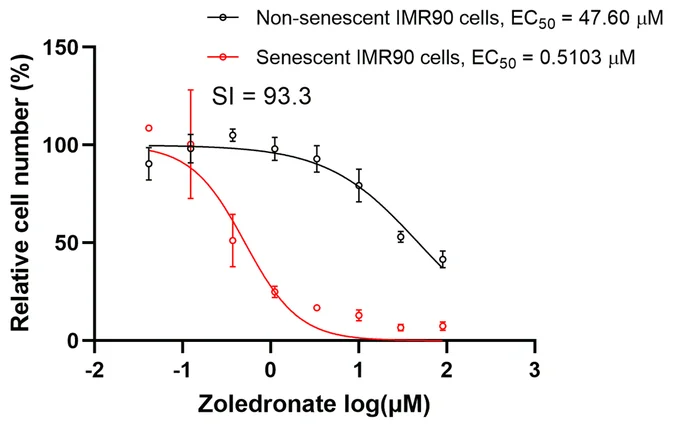Researchers publishing in Aging have investigated zoledronic acid, a drug already used to protect bones and fight osteoporosis, for its activity against cellular senescence.
An approved drug with established effects
Zoledronate has already been approved by the FDA for clinical use, as it has been prescribed to prevent bone fractures in vulnerable people for more than two decades [1]. While previous research has found that zoledronate is associated with reduced all-cause mortality [2], and it was found to decelerate aging in fruit flies, a meta-analysis has placed these results into question [3]. Therefore, figuring out what zoledronate is, and isn’t, doing in the human body has become the subject of research.

Read More
These researchers note that some of the observed benefits in previous studies have matched those of senolytics. Therefore, they turned their sights in that direction, attempting to determine if zoledronate itself is in that category.
Selective senescent cell removal
For their in vitro experiment, the researchers used a standard choice of senescent cells: human lung fibroblasts (IMR90) that have been driven senescent by exposure to etoposide. These cells, along with a control group of non-senescent IMR90, were exposed to zoledronate at various concentrations. The results showed significant, and highly selective, senolytic activity: zoledronate preferentially removed senescent cells while leaving normal cells mostly intact.

The researchers confirmed these results in a sample of murine embryonic cells that were genetically prone to senescence and compared them to a control group, and the results were similar.
Benefits in living animals
The next experiment involved wild-type, naturally aged mice. 24-month-old mice that had been treated with zoledronate for eight weeks were compared to an untreated control group and given three separate physical challenges as well as protein tests for SASP components.
In the two endurance-related physical challenges of hang time and treadmill running, the zoledronate-treated mice appeared to perform better, but the results did not reach the level of statistical significance. However, in the grip strength test, the results were statistically significant: the treated mice had stronger grips. All four of the tested SASP proteins were significantly decreased in the treated groups.
The effects on bone were also tested, and the physical results were unsurprising: zoledronate works on mice just as it is prescribed to work in people, reducing the effects of bone-destroying osteoclasts. Interestingly, however, the researchers found a group of pre-osteoclastic cells that showed significant markers of senescence and that were being removed by zoledronate. These results suggest that senolytic activity is a large part of why zoledronate works for its prescribed application. The first senolytic drug may already have been in the clinic for decades.
Clinically approved, with caveats
Zoledronate is still a prescription drug with known side effects, and the doses and administration methods that are appropriate to remove other senescent cell populations may be totally different from its current prescriptions for bone protection and cancer treatment. Human volunteers must be recruited to determine if there are appropriate doses of zoledronate that can eliminate other populations of the senescent cells that build up with age. It may also be possible to develop a different drug that is specifically targeted towards pre-osteoclastic senescent cells and has fewer side effects.
Literature
[1] Reid, I. R., Green, J. R., Lyles, K. W., Reid, D. M., Trechsel, U., Hosking, D. J., … & Eriksen, E. F. (2020). Zoledronate. Bone, 137, 115390.
[2] Lyles, K. W., Colón-Emeric, C. S., Magaziner, J. S., Adachi, J. D., Pieper, C. F., Mautalen, C., … & Boonen, S. (2007). Zoledronic acid and clinical fractures and mortality after hip fracture. New England Journal of Medicine, 357(18), 1799-1809.
[3] Cummings, S. R., Lui, L. Y., Eastell, R., & Allen, I. E. (2019). Association between drug treatments for patients with osteoporosis and overall mortality rates: a meta-analysis. JAMA internal medicine, 179(11), 1491-1500.







